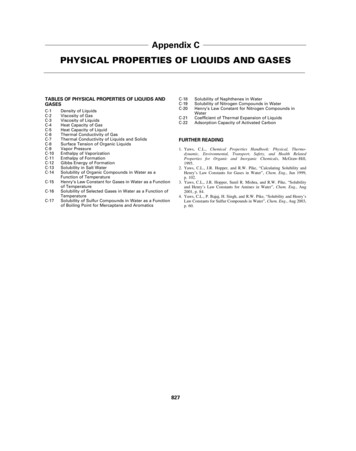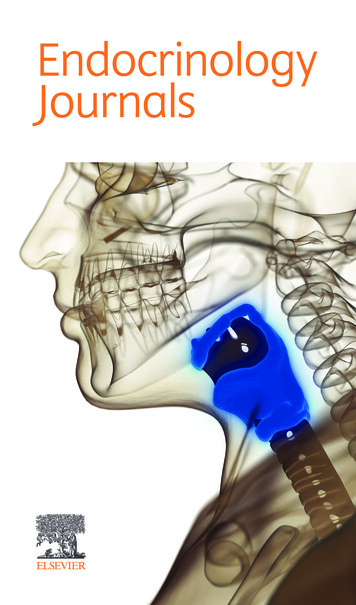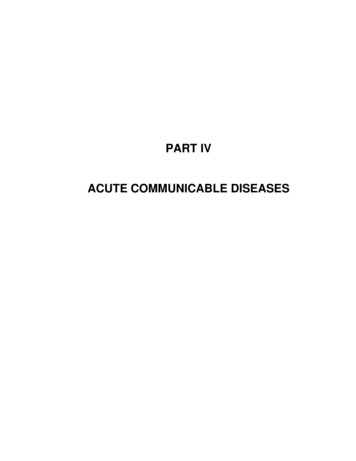
Transcription
The New Public HealthSecond Edition
science &ELSEVIERtechnology booksCompanion Web 123708908The New Public Health, Second Editionby Theodore H. Tulchinsky and Elena A. VaravikovaResources for Professors: All figures from the book available as PowerPoint slides Links to web sites carefully chosen to supplement the content of the textbook PowerPoint lecture slides by the authors on topics related to the chapters Case studies Instructor’s GuideTOOLSFORTEACHING NEEDSALL textbooks.elsevier.comYOURACADEMICPRESSTo adopt this book for course use, visit http://textbooks.elsevier.com
The New Public HealthSecond EditionTheodore H. Tulchinsky, MD, MPHBraun School of Public Health and Community MedicineHebrew University-Hadassah, Ein KaremJerusalem, IsraelElena A. Varavikova, MD, MPH, PhDI. M. Sechenov Moscow Medical AcademyMoscow, Russian FederationWith Foreword byJohn Last, MD, DPH, FRACP, FFPH, FRCPC, FACPM, FACEMD (Hon) Edinburgh and UppsalaProfessor Emeritus, University of OttawaOttawa, Ontario, CanadaAMSTERDAM BOSTON HEIDELBERG LONDON NEW YORK OXFORD PARISSAN DIEGO SAN FRANCISCO SINGAPORE SYDNEY TOKYOAcademic Press is an Imprint of Elsevier
Elsevier Academic Press30 Corporate Drive, Suite 400, Burlington, MA 01803, USA525 B Street, Suite 1900, San Diego, California 92101-4495, USA84 Theobald’s Road, London WC1X 8RR, UKThis book is printed on acid-free paper.Copyright # 2009, Elsevier Inc. All rights reserved.No part of this publication may be reproduced or transmitted in any form or by anymeans, electronic or mechanical, including photocopy, recording, or any informationstorage and retrieval system, without permission in writing from the publisher.Permissions may be sought directly from Elsevier’s Science & Technology RightsDepartment in Oxford, UK: phone: (þ44) 1865 843830, fax: (þ44) 1865 853333,E-mail: permissions@elsevier.co.uk. You may also complete your request on-linevia the Elsevier homepage (http://elsevier.com), by selecting“Customer Support” and then “Obtaining Permissions.”Library of Congress Cataloging-in-Publication DataTulchinsky, Theodore H.The new public health / authors, Theodore H. Tulchinsky, Elena A. Varavikova ; withforeword by John Last. – 2nd ed.p. ; cm.Includes bibliographical references and index.ISBN 978-0-12-370890-8 (hardcover : alk. paper) 1. Public health. I. Varavikova,Elena. II. Title.[DNLM: 1. Public Health–trends. WA 100 T917n 2009]RA425.T77 2009362.1–dc222008027586British Library Cataloguing in Publication DataA catalogue record for this book is available from the British LibraryISBN 13: 978-0-12-370890-8For all information on all Elsevier Academic Press publicationsvisit our Web site at www.elsevierdirect.comPrinted in the United States of America08 09 10 9 8 7 6 5 4321
DedicationWe wish to dedicate this book to our families, professionalcolleagues, and friends who sustained and supported us inthe hard labor for five years on the first edition and twoyears on the second edition through the ups and downsof such an endeavor.Theodore Tulchinsky: I would like to dedicate thisbook to my family; to my wife, Joan, and our childrenDaniel, Joel, and Karen, and their children; to my late parents Ann and Harry Tulchinsky; and to my sisters Normaand Ruth and brother Gerald and their families.Elena Varavikova: I wish to especially thank Natalya,Tatyana, Inna, and Harvey for their support andinspiration.We jointly dedicate this book to all those who sustained us and contributed to its development and its translations into Russian and many languages of EasternEurope and Central Asia, including Albanian, Bulgarian,Georgian, Moldovan, Macedonian, Mongolian, Romanian,and Uzbek. We make a special dedication to Milton andRuth Roemer, whose contributions to public health in theUnited States and globally were enormous, and whosefriendship and encouragement with this book were veryspecial to its preparation.v
Special DedicationMilton and Ruth Roemerhealth, fluoridation of community water, and abortionrights. Her work from 1993 onward contributed to theWHO Framework Convention on Tobacco Control of2003. Milton died in Los Angeles in 2001 at age 84, andRuth in 2005, at age 89.MILTON I. ROEMERThis special dedication to Ruth and Milton Roemer is inrecognition of their leadership in public health and healthcare organization, and also for their warm support andfriendship while the first edition of this textbook was stillin its early stages. Milton wrote the Foreword for the firstedition, and Ruth helped us to connect with AcademicPress of San Diego, our publisher.Milton Roemer was a world-renowned scholar in manyareas of public health, including international health,primary care, rural health, and health care organization.Roemer’s many notable achievements included studiesshowing that in an insured population, a hospital bed builtis a hospital bed filled—a finding that contributed to theenactment of certificate of need legislation and comprehensive health planning. This finding was so robust thatit bears his name: Roemer’s Law, as discussed in thisbook.Ruth Roemer was a role model and leader in manypublic health issues such as tobacco control, mentalMilton I. Roemer, MD, MPH, was one of the most influentialpublic health figures of the twentieth century; his work overmore than six decades benefited the lives of millions ofpeople all over the world. He worked in 71 countries andpublished 32 books and 430 articles on the social aspects ofhealth services. During his career he consistently proved prescient in foreseeing health trends and possibilities, includingdevelopment of HMOs, promoting the role of ambulatorycare, and documenting the need for national health insurancefor the entire U.S. population. He advocated development ofdoctoral training in health administration to prepare studentsfor leadership in public health practice, and established anendowed fellowship to support students in the program.Roemer received his master’s degree in sociology fromCornell University in 1939, his MD from New YorkUniversity in 1940, and a public health degree from theUniversity of Michigan in 1943. He served at all levels ofhealth administration—county, state, national, and international. As a medical officer of the New Jersey StateHealth Department, he supervised 92 venereal diseaseclinics. During World War II, he served as a member ofthe commissioned corps of the U.S. Public Health Service.His 1948 book Rural Health and Medical Care, withF. D. Mott, was the first to systematically analyze ruralhealth care needs and services in the United States. Ascounty health officer of Monongalia County, West Virginia, he introduced public health innovations, includingpioneering a cancer detection clinic for the mining community. Roemer was among the first to advocate integration of public health and medical care. In 1953, he wasappointed director of medical and hospital services ofthe Saskatchewan, Canada, Department of Public Health,North America’s first social insurance program for hospital care. After teaching at Yale and Cornell, Roemer cameto the University of California–Los Angeles (UCLA)vii
viiiSchool of Public Health in 1962, where he taught healthadministration, conducted research and continued to publish for 38 years. The capstone of Roemer’s many publications was his two-volume work, National Health Systemsof the World, a monumental comparative analysis ofnational health systems of countries of the world.RUTH ROEMERRuth Roemer, JD, was a pioneer in public health law andadvocacy whose career spanned more than 50 years.Roemer made lasting contributions in areas that includedreproductive health services, environmental health, tobaccocontrol, and health services organization. She remainedan influential figure in public health well into her 80s,initiating what later became the International FrameworkConvention on Tobacco Control, adopted by the WorldHealth Organization in 2003.Born Ruth Joy Rosenbaum in Hartford, Connecticut,Roemer graduated from Cornell Law School and beganher career as a labor lawyer. She switched to healthlaw in the 1960s after participating in a landmark studyof the laws governing admission to mental hospitals inSpecial Dedicationthe State of New York. She joined the UCLA Schoolof Public Health faculty in 1962, and promptly becameprincipal organizer and vice president of the CaliforniaCommittee on Therapeutic Abortion, to provide publiceducation and leadership in reform of California’s century-old abortion law. The group spearheaded abortionlaw reform in California in 1967, 6 years before theU.S. Supreme Court’s decision in Roe v. Wade. Inensuing years she made her mark with analyses of thefunctions, education, and regulation of health personneland as an ardent campaigner for fluoridation of publicwater supplies in California and worldwide. In an early1970s study she examined the gap between the advancedtechnology to roll back pollution and its application toprotect people’s health and living conditions. She pioneered with a seminal work on tobacco control with aworld review of tobacco control legislation for the WorldHealth Organization, first published in 1982. She wasactive in international tobacco control conferences, andhelped prepare a document that led to WHO’s first international convention on tobacco control and the treatyadopted in 2003. Ruth Roemer taught health law, ethics,and policy at UCLA.
ContentsForewordPreface to the Second EditionAcknowledgmentsIntroduction to the First Editionxviixixxxixxiii1. A History of Public Health1IntroductionPrehistoric SocietiesThe Ancient WorldThe Early Medieval Period (Fifth toTenth Centuries CE)The Late Medieval Period (Eleventh toFifteenth Centuries)The Renaissance (1500–1750)Enlightenment, Science, and Revolution (1750–1830)Eighteenth-Century ReformsApplied EpidemiologyJenner and VaccinationFoundations of Health Statistics and EpidemiologySocial Reform and the SanitaryMovement (1830–1875)Snow on CholeraGerm Versus Miasma TheoriesHospital ReformThe Bacteriologic RevolutionPasteur, Cohn, Koch, and ListerVector-Borne DiseaseMicrobiology and ImmunologyPoliomyelitisAdvances in Treatment of Infectious DiseasesMaternal and Child HealthNutrition in Public HealthMilitary MedicineInternationalization of HealthThe Epidemiologic TransitionAchievements of Public Health in theTwentieth CenturyCreating and Managing Health SystemsSummaryHistorical MarkersElectronic 2526262831Recommended ReadingsBibliography31322. Expanding the Concept ofPublic Health33IntroductionConcepts of Public HealthEvolution of Public HealthHealth and DiseaseHost–Agent–Environment ParadigmThe Natural History of DiseaseSociety and HealthModes of PreventionHealth PromotionPrimary PreventionSecondary PreventionTertiary PreventionDemographic and Epidemiologic TransitionInterdependence of Health ServicesDefining Public HealthSocial Medicine and Community HealthSocial Hygiene Eugenics, and Corruptionof Public Health ConceptsMedical EcologyCommunity-Oriented Primary CareWorld Health Organization’s Definition of HealthAlma-Ata: Health for AllSelective Primary CareThe Risk ApproachThe Case for ActionPolitical Economy and HealthHealth and DevelopmentHealth Systems: The Case for ReformAdvocacy and ConsumerismProfessional Advocacy and ResistanceConsumerismThe Health Field ConceptThe Value of Medical Care in Public HealthHealth TargetsUnited States Health TargetsInternational Health TargetsEuropean Health 95050525354555557585859596161ix
xContentsUnited Kingdom Health TargetsIndividual and Community Participation in HealthOttawa Charter for Health PromotionState and Community Models of Health PromotionHealthy Cities/Towns/MunicipalitiesHuman Ecology and Health PromotionDefining Public Health StandardsIntegrative Approaches to Public HealthThe Future of Public HealthThe New Public HealthSummaryElectronic ResourcesRecommended ReadingsBibliography61626263636565666768687071713. Measuring and Evaluating theHealth of a ion PyramidLife ExpectancyEpidemiologySocial EpidemiologyEpidemiology in Building Health PolicyDefinitions and Methods ofEpidemiologyRates and RatiosMeasures of MorbidityPrevalence RatesMeasures of MortalitySocial ClassificationSentinel EventsThe Burden of DiseaseYears of Potential Life LostQualitative Measures of Morbidityand MortalityMeasurementResearch and Survey MethodsVariablesThe Null HypothesisConfoundersSamplingRandomizationNormal DistributionStandardization of RatesDirect Method of StandardizationIndirect Method of StandardizationPotential Errors in MeasurementReliabilityValidityScreening for DiseaseEpidemiologic 0919191929293939494959596Observational StudiesExperimental EpidemiologyEstablishing Causal RelationshipsNotification of DiseasesSpecial Registries and ReportingSystemsDisease ClassificationHospital Discharge InformationHealth Information Systems (Informatics)WHO European Region Health forAll DatabaseSurveillance, Reporting, and PublicationAssessing the Health of the IndividualAssessment of Population HealthDefining the PopulationSocioeconomic StatusNutritionEnvironment and OccupationHealth Care Financing and OrganizationHealth Care ResourcesUtilization of ServicesHealth Care OutcomesQuality of CareSelf-Assessment of HealthCosts and BenefitsEffects of InterventionQualitative MethodsSummary — From Information to Knowledgeto PolicyElectronic ResourcesRecommended ReadingsBibliography4. Communicable DiseasesIntroductionPublic Health and the Controlof Communicable DiseaseThe Nature of Communicable DiseaseHost–Agent–Environment TriadClassifications of CommunicableDiseasesModes of Transmission of DiseaseImmunitySurveillanceHealth Care–Associated InfectionsEndemic and Epidemic DiseaseEpidemic InvestigationControl of Communicable DiseasesTreatmentMethods of PreventionVaccine-Preventable DiseasesImmunization CoverageVaccine-Preventable 22122123124125125126128128129130130130131133144
xiContentsEssentials of an Immunization ProgramRegulation of VaccinesVaccine DevelopmentControl/Eradication of InfectiousDiseasesSmallpoxEradication of PoliomyelitisOther Candidates for EradicationFuture Candidates for EradicationVector-Borne DiseasesMalariaRickettsial InfectionsArboviruses (Arthropod-BorneViral Diseases)Lyme DiseaseParasitic sOther Parasitic DiseasesLegionnaire’s DiseaseLeprosyTrachomaSexually Transmitted InfectionsSyphilisGonorrheaOther Sexually Transmitted InfectionsControl of Sexually Transmitted InfectionsHIV/AIDSDiarrheal DiseasesSalmonellaShigellaEscherichia coliCholeraViral GastroenteritisParasitic GastroenteritisA Program Approach toDiarrheal Disease ControlAcute Respiratory InfectionsInequalities in Control ofCommunicable DiseasesCommunicable Disease Controlin the New Public HealthSummaryElectronic ResourcesRecommended ReadingsBibliography5. Noncommunicable 6176177177181181The Rise of Chronic DiseaseThe Burden of Chronic ConditionsRisk Factors and Causation of Chronic ConditionsChronic Manifestations of Infectious DiseasesCardiovascular DiseasesChronic Lung DiseaseAsthmaChronic Obstructive Pulmonary DiseaseRestrictive Lung DiseasesOccupational Lung DiseasesDiabetes MellitusPrevention of Diabetes and Its ComplicationsEnd-Stage Renal DiseaseCancerPrevention of CancerChronic Liver DiseaseDisabling ConditionsArthritis and Musculoskeletal DisordersOsteoporosisDegenerative OsteoarthritisRheumatoid Arthritis and GoutLow Back SyndromesNeurologic DisordersAlzheimer’s DiseaseParkinson’s DiseaseMultiple SclerosisEpilepsy or SeizuresBrain and Spinal Cord InjuryVisual DisordersHearing DisordersTrauma, Violence, and InjuryMotor Vehicle AccidentsDomestic ViolenceSuicide and Suicide AttemptsHomicidePrevention of ViolenceChronic Conditions and the New Public HealthSummaryElectronic ResourcesRecommended ReadingsBibliography6. Family HealthIntroductionThe Family UnitMaternal HealthFertilityPublic Health Concerns of FertilityFamily PlanningMaternal Mortality and MorbidityPregnancy CareHigh-Risk PregnancyLabor and DeliverySafe Motherhood 20220221223224226227
xiiCare of the NewbornCare in the PuerperiumGenetic and Birth DisordersRhesus Hemolytic Disease ofthe NewbornNeural Tube DefectsCerebral PalsyIntellectual DisabilityDown SyndromeCystic FibrosisSickle-Cell DiseaseThalassemiaPhenylketonuriaCongenital HypothyroidismFetal Alcohol SyndromeTay-Sachs DiseaseG6PDFamilial Mediterranean FeverInfant and Child HealthFetal and Infant MortalityInfancy Care and FeedingAnticipatory CounselingDocumentation, Records,and MonitoringThe Preschooler (Ages 1–5 Years)School and Adolescent HealthSmokingAlcohol AbuseDrug AbuseSexual Risk BehaviorDietary Risk BehaviorPhysical ActivityViolence and Gang BehaviorAdult HealthWomen’s HealthMen’s HealthHealth of Older AdultsHealth Maintenance for Older AdultsSummaryElectronic ResourcesRecommended 2422432432442442452452452462482492502542552562567. Special Community Health Needs259IntroductionMental HealthHistorical Changes in Methods of TreatmentMental Health EpidemiologyMental Disorder SyndromesControversies in Mental Health PoliciesCommunity-Oriented Mental HealthPrevention and Health PromotionMental Disability259260262263265269270271271Oral HealthFluoridationPeriodontal DiseaseDental CareOral CancerPhysical Disability and RehabilitationSpecial Group Health NeedsGay and Lesbian HealthNative Peoples’ HealthPrisoners’ HealthMigrant Population HealthHomeless Population HealthRefugee HealthMilitary MedicineHealth in DisastersSummaryElectronic ResourcesRecommended 2802802812822832862872872888. Nutrition and Food Safety291IntroductionDevelopment of Nutrition inPublic HealthNutrition in a Global ContextNutrition and InfectionFunctions of FoodComposition of the Human BodyHuman Nutritional RequirementsCarbohydratesProteinsFats and OilsVitaminsMinerals and Trace ElementsGrowthMeasuring Body MassRecommended Dietary IntakesDisorders of UndernutritionUnderweight: Protein-Energy Malnutrition (PEM)Failure to ThriveMarasmusKwashiorkorVitamin A DeficiencyVitamin D Deficiency (Rickets and Osteomalacia)Vitamin C DeficiencyVitamin K Deficiency (HemorrhagicDisease of the Newborn)Vitamin B DeficienciesIron-Deficiency AnemiaIodine-Deficiency DiseasesOsteoporosisEating DisordersDiseases of 312
xiiiContentsOverweight/ObesityCardiovascular DiseasesCancerNutrition in Pregnancy and LactationPromoting Healthy Diets and LifestylesDietary GuidelinesVitamin and Mineral Enrichment of BasicFoodsControversy in Food EnrichmentFood and Nutrition PolicyThe Evolution of a Federal RoleNutrition Issues in Development PoliciesThe Role of the Private Sector and NGOsThe Role of Health ProvidersNutrition Monitoring and EvaluationStandard Reference PopulationsMeasuring Deviation from theReference PopulationFood Quality and SafetyNutrition and the New Public HealthSummaryElectronic ResourcesRecommended ReadingsBibliography9. Environmental and OccupationalHealthENVIRONMENTAL HEALTHIntroductionEnvironmental IssuesGeographic and Environmental EpidemiologyEnvironmental TargetsGlobal Environmental ChangeClimate ChangeEnvironmental Impact on Health Burdenof DiseaseCommunity Water SuppliesWaterborne DiseasesSewage Collection and TreatmentToxinsToxic Effects on FertilityToxic Effects of Lead in the EnvironmentAgricultural and Environmental HazardsAir PollutionThe External EnvironmentMethyl Tertiary Butyl EtherIndoor PollutionRadon GasOutdoor–Indoor PollutantsBiological PollutantsSick Building SyndromeHazardous or Toxic WastesMinimata DiseaseToxic Waste 0351351RadiationIonizing RadiationNon-Ionizing RadiationEnvironmental ImpactEmergency Events Involving HazardousSubstancesMan-Made Disasters, War, TerrorismPreventing and Managing EnvironmentalEmergenciesEnvironmental Health OrganizationOCCUPATIONAL HEALTHIntroductionDevelopment of Occupational HealthThe Health of WorkersThe Burden of Occupational Morbidityand MortalityOccupational Health Priorities in theUnited StatesInternational Issues in Occupational HealthNational and ManagementResponsibilitiesStandards and MonitoringOccupational Health TargetsToxicity at the Workplace and in the EnvironmentLeadAsbestosSilicaCotton Dust (Byssinosis)Vinyl ChlorideAgent OrangeWorkplace ViolenceOccupational Health in Clinical PracticeInspecting the Place of WorkRisk AssessmentPreventing Disasters in the WorkplaceOccupation and the New Public HealthSummaryElectronic ResourcesRecommended ReadingsBibliography — Water Quality and WaterborneDiseaseBibliography — Occupational and EnvironmentalHealth10. Organization of Public HealthSystemsIntroductionGovernment and Health of the NationFederal and Unitary StatesChecks and Balances in Health AuthorityGovernment and the IndividualFunctions of Public HealthRegulatory Functions of Public 8368369369370371372373375375376377377378378379
xivMethods of Providing or AssuringServices — Direct or Indirect?Nongovernmental Roles in HealthDisasters and Public Health PreparednessMedical Practice and Public HealthIncentives and RegulationPromotion of Research and TeachingAccreditation and Quality RegulationNational Government PublicHealth ServicesState Government Public Health ServicesLocal Health AuthoritiesMonitoring Health StatusNational Health TargetsUniversal Health Coverage and theNew Public HealthHospitals in the New Public HealthHospital ClassificationSupply of Hospital BedsThe Changing Role of the HospitalRegulation of HospitalsThe Uninsured as a Public HealthChallengeSummaryElectronic ResourcesRecommended ReadingsBibliography11. Measuring Costs: The Economicsof HealthIntroductionEconomic Issues of Health SystemsInvesting in HealthNational Health Care SpendingBasic Concepts in Health EconomicsSupply, Need, Demand, andUtilization of Health ServicesNormative NeedsFelt NeedExpressed NeedComparative NeedDemandSupplyGrossman’s Demand ModelCompetition in Health CareElasticities of DemandMeasuring CostsEconomic Measures of Health StatusCost–Effectiveness AnalysisCost–Benefit AnalysisBasic Assessment Scheme forIntervention Costs and ConsequencesThe Value of Human lth Financing — The Macroeconomic LevelCosts of IllnessCosts and Variations in Medical PracticeCost ContainmentMedical and HospitalCare — MicroeconomicsPayment for Doctor’s ServicesPayment for Comprehensive CareHealth Maintenance and Managed CareOrganizationsDistrict Health SystemsPaying for Hospital CareCapital CostsHospital Supply, Utilization, and CostsModified Market ForcesEconomics and the New Public HealthSummaryElectronic ResourcesRecommended ReadingsBibliography12. Planning and ManagingHealth SystemsIntroductionHealth Policy and Planning as ContextThe Elements of OrganizationsScientific ManagementBureaucratic Pyramidal OrganizationsOrganizations as Energy SystemsCybernetics and ManagementTarget-Oriented ManagementOperations ResearchManagement by ObjectivesHuman Relations ManagementThe Hawthorne EffectMaslow’s Hierarchy of NeedsTheory X–Theory YNetwork OrganizationTotal Quality ManagementChanging Human BehaviorEmpowermentStrategic Management of Health SystemsHealth System Organization ModelsFunctional ModelCorporate ModelMatrix ModelSkills for ManagementThe Chief Executive Officer ofHealth OrganizationsCommunity ParticipationIntegration — Lateral and VerticalNorms and Performance IndicatorsHealth Promotion and 57
xvContentsPhilanthropy and VolunteerismNew Organizational ModelsNew Projects and Their EvaluationSystems Approach andthe New Public HealthSummaryElectronic ResourcesRecommended ReadingsBibliography13. National Health SystemsIntroductionHealth Systems in Developed CountriesEvolution of Health SystemsThe United StatesFederal Health InitiativesMedicare and MedicaidThe Changing Health Care EnvironmentHealth InformationHealth TargetsSocial InequitiesThe Dilemma of the UninsuredSummaryCanadaReform Pressures and InitiativesProvincial Health ReformsHealth StatusSummaryThe United KingdomThe National Health ServiceStructural Reforms of theNational Health ServiceReforms Since 1990Social InequitiesHealth PromotionHealth ReformsPrimary Care TrustsSummaryThe Nordic CountriesSwedenDenmarkNorwayFinlandWestern EuropeGermanyThe NetherlandsRussiaThe Soviet ModelEpidemiologic TransitionPost-Soviet ReformFuture 4495496497499501501502Origins of the Israeli Health SystemHealth Resources and ExpendituresHealth ReformsMental HealthHealthy Israel 2020SummaryHealth Systems in DevelopingCountriesFederal Republic of NigeriaSummaryLatin America and the CaribbeanColombiaAsiaChinaJapanComparing National Health SystemsEconomic Issues in NationalHealth SystemsReforming National Health SystemsSummaryElectronic ResourcesRecommended ReadingsBibliography14. Human Resources for Health CareIntroductionOverview of Human ResourcesHuman Resources PlanningSupply and DemandBasic Medical EducationPostgraduate Medical TrainingSpecialization and Family PracticeTraining in Preventive MedicineNursing EducationIn-Service and Continuing EducationAccreditation of Medical Educational orTraining FacilitiesThe Range of Health DisciplinesLicensure and SupervisionConstraints on the Health Care ProviderNew Health ProfessionsNurse PractitionersPhysician AssistantsFeldshersCommunity Health WorkersAlternative MedicineChanging the BalanceEducation for Public Health andHealth ManagementHealth Policy and Management ofHuman ResourcesSummaryElectronic 45547547548548549550550551552552553554554560561561
xviRecommended ReadingsBibliography15. Health Technology, Quality,Law, and EthicsIntroductionInnovation, Regulation, and QualityControlAppropriate Health TechnologyHealth Technology AssessmentTechnology Assessment in HospitalsTechnology Assessment in Prevention andHealth PromotionTechnology Assessment in NationalHealth SystemsDissemination of TechnologyDiffusion of TechnologyQuality AssuranceAdverse Events and NegligenceLicensure and CertificationHealth Facility AccreditationPeer ReviewAlgorithms and Clinical GuidelinesOrganization of CareDiagnosis-Related GroupsManaged CarePerformance IndicatorsConsumerism and QualityThe Public InterestTotal Quality ManagementPublic Health LawEnvironmental HealthPublic Health Law ReformEthical Issues in Public HealthIndividual and Community RightsEthics in Public Health ResearchEthics in Patient CareEthics in Public HealthHuman ExperimentationSanctity of Life Versus EuthanasiaThe Imperative to Act or Not Act inPublic 1593595596596597598598SummaryElectronic ResourcesRecommended ReadingsBibliography16. Globalization of HealthIntroductionThe Global Health SituationPriorities in Global Child HealthMaternal HealthPopulation GrowthMalnutritionThe Fight Against HIV/AIDS and OtherCommunicable DiseasesChronic DiseaseDisaster ManagementEnvironmentGlobal Partnership for DevelopmentDevelopment and HealthOrganization for International HealthThe World Health OrganizationThe United Nations Children’sFund (UNICEF)Nongovernmental OrganizationsThe World BankTrends in Global HealthEmerging Infectious Disease ThreatsExpanding National Health CapacityGlobal Health and the New Public HealthSummaryElectronic ResourcesRecommended ReadingsBibliographyPublications and JournalsGlossary of 634635636637659
ForewordThe foreword to the first edition of this book (2000) waswritten by the eminent authority on public health, the lateMilton Roemer. It is fitting that the authors have dedicatedthis edition to him and to his late wife Ruth Roemer, also adistinguished contributor to public health. It is an honor tobe invited to follow where Milton Roemer led, and to contribute the Foreword to this second edition of the book.I read the first edition with admiration and great interest. Admiration because the two authors had done such asplendid job in covering all the important bases so thoroughly; and with great interest because I had by then edited several editions of a large, comprehensive textbook ofpublic health and preventive medicine; had written oneof my own; and had been teaching, professing, and mentoring on many aspects of the subject for several decades.This book is based on rich ex
nia, he introduced public health innovations, including pioneering a cancer detection clinic for the mining com-munity. Roemer was among the first to advocate integra-tion of public health and medical care. In 1953, he was appointed director of medical and hospital services of the Saskatchew










